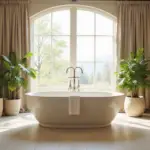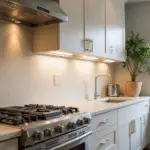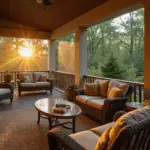Introduction
Your deck isn’t just an extension of your home—it’s prime real estate for creating a living, breathing outdoor sanctuary. As an urban garden specialist, I’ve seen countless decks transformed from bland wooden platforms into vibrant spaces that nourish both body and soul.
Whether you’re looking to entertain, grow food, or simply create a peaceful retreat, thoughtful deck decor makes all the difference. I’ve gathered 21 ideas that balance aesthetics with functionality, perfect for urban dwellers who want to maximize their outdoor living potential. From comfortable seating arrangements to creative growing solutions, these suggestions will help you create a deck that feels like a natural extension of your home and values.
The inspiration for this collection struck when I realized how many urban gardeners struggle to balance beautiful design with productive growing spaces. Let’s explore how to create a deck that does both.
1. Choose Comfortable and Stylish Outdoor Seating
The cornerstone of any inviting deck is seating that beckons you to sit and stay awhile. Look beyond basic plastic chairs and consider weather-resistant materials like teak, synthetic wicker, or powder-coated aluminum that can withstand the elements while providing genuine comfort. The key is finding pieces that serve double duty—offering both support for long conversations and style that complements your home’s architecture.

For urban gardeners, multifunctional seating is particularly valuable. Consider benches with hidden storage for garden tools, sectionals with washable covers that can handle a bit of soil, or chairs that can be easily reconfigured around a harvest table when it’s time to share your garden’s bounty. Layer with outdoor-rated cushions and throws in colors that complement your plantings for a cohesive look.
The magic of this piece lies in its ability to create a foundation for everything else. Once your seating invites lingering, you’ll want to define that area more clearly with an outdoor rug.
2. Anchor Your Space with an Outdoor Rug
An outdoor rug instantly transforms your deck from a wooden platform into a defined living area. It creates visual boundaries, adds texture underfoot, and helps group furniture into purposeful arrangements. For decks that serve as growing spaces, rugs can delineate between planting zones and relaxation areas.

When selecting a rug for your deck decor, prioritize materials specifically designed for outdoor exposure. Polypropylene (olefin) rugs resist fading, mildew, and moisture—perfect for areas that might get splashed during watering. Look for options made from recycled materials if sustainability is important to you. Size matters too; ensure the rug is large enough that at least the front legs of all furniture pieces rest comfortably on it.
What surprises clients most is how this works with vertical gardens and container plants, creating a natural flow between soft textiles and living elements. As evening approaches, you’ll want to enhance this cozy atmosphere with thoughtful lighting.
3. Create Ambiance with String Lights or Lanterns
After months of sourcing and curation, I’ve found that nothing transforms a deck’s mood quite like well-planned lighting. String lights suspended overhead create a ceiling of gentle illumination, while lanterns placed strategically on tables and steps add depth and dimension to your deck decor after sunset.

For urban gardeners, lighting serves multiple purposes: extending harvest time into evening hours, highlighting prized plants, and creating a magical dining atmosphere surrounded by your edible landscape. Consider solar-powered options to minimize energy use, or look for warm-toned LED lights that won’t attract as many insects around your plants. Mixing light sources at different heights—overhead string lights, mid-level lanterns, and low path lights—creates a layered effect that mimics natural light patterns.
- Edison-style bulbs provide a warm, nostalgic glow
- Solar lanterns eliminate the need for outlets or cords
- Clip lights can highlight specific plants or features
- Candle lanterns add movement and natural light
The environmental story behind this piece began with the need to extend usable outdoor time while minimizing energy consumption. Now let’s explore how plants can transform your deck into a lush oasis.
4. Incorporate Lush Container Plants
The journey from bare deck to thriving garden begins with strategic container plantings. Containers allow urban gardeners to maximize growing potential on even the smallest decks, turning horizontal and vertical spaces into productive gardens. The visual weight balances perfectly when you mix ornamental and edible plants—think trailing nasturtiums (both beautiful and edible) alongside compact tomato varieties or colorful Swiss chard.
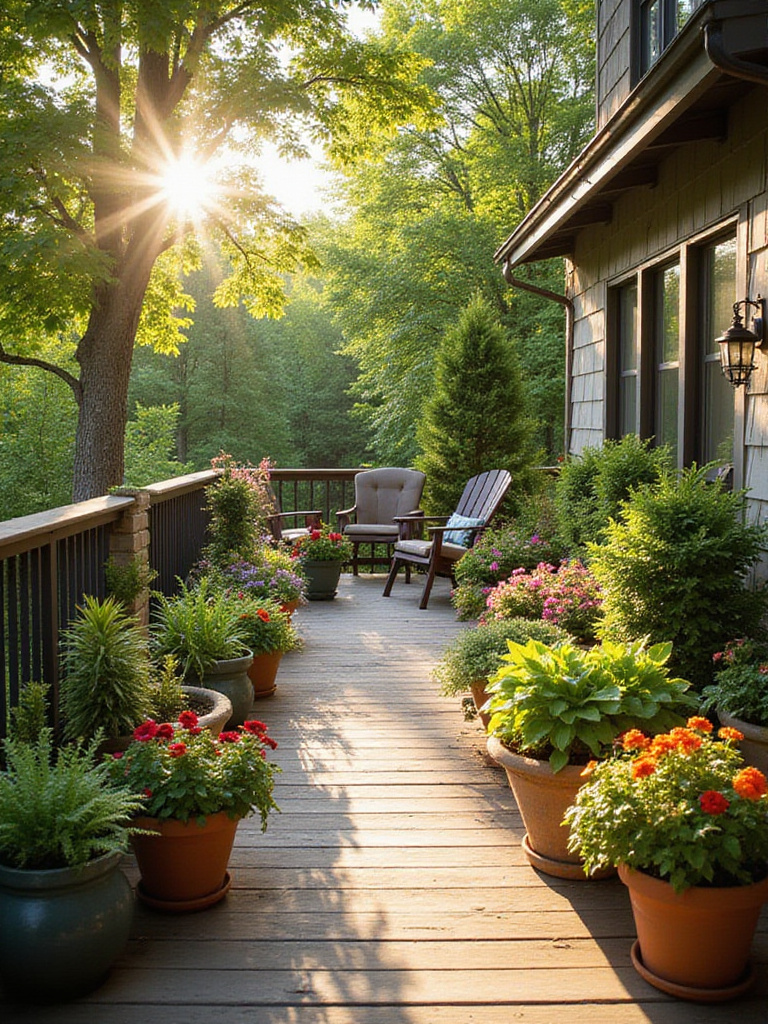
When selecting containers, consider weight restrictions for your deck structure and ensure proper drainage. Self-watering containers work wonderfully for busy urbanites, while fabric grow bags allow roots to breathe and prevent overheating in sunny locations. Group plants with similar water and light needs together, and don’t be afraid to play with height—place tall growers like indeterminate tomatoes or trellised cucumbers at the back, medium plants in the middle, and cascading herbs or flowers at the edge.
“The most successful deck gardens combine beauty and function—lettuce becomes a border plant, blueberries serve as focal points, and vertical herb gardens double as privacy screens.”
The unexpected pairing that always works is combining textural plants like ornamental grasses with productive edibles like peppers or eggplants. As you build your container garden, you’ll want to add color accents that complement your growing greenery.
5. Add Pops of Color with Outdoor Cushions and Throws
While designing urban garden decks, I’ve noticed how quality textiles can transform the space from purely functional to wonderfully inviting. Outdoor cushions, pillows, and throws aren’t just decorative—they’re an invitation to linger among your plants, connecting you more deeply with the growing environment you’ve created.

Choose fabrics specifically designed for outdoor use, like solution-dyed acrylics that resist fading and mildew. For deck decor that complements an edible landscape, consider colors inspired by your plantings—the deep purple of eggplant, the vibrant red of ripe tomatoes, or the silvery-green of sage. These natural color connections create visual harmony between your seating areas and growing spaces. Waterproof storage options keep textiles clean and dry during rainy periods, extending their lifespan considerably.
The cultural heritage preserved in each piece includes traditional garden-inspired patterns like botanical prints and vegetable motifs that celebrate the growing tradition. Sometimes, however, you need more than just color to create privacy in your outdoor sanctuary.
6. Install a Privacy Screen or Trellis
If you’ve struggled with similar rooms before, you know that urban decks often face direct views from neighboring properties. A thoughtfully designed privacy screen transforms an exposed deck into a secluded retreat while simultaneously creating growing opportunities. The dual-purpose nature of these structures makes them particularly valuable for urban gardeners working with limited space.

When selecting materials, consider how they’ll interact with your plants and overall aesthetic. Cedar or redwood screens offer natural beauty and weather resistance, while metal panels can provide contemporary style and durability. For the urban gardener, combining solid sections for privacy with open trellis sections for climbing plants offers the best of both worlds. Vertical growing space for beans, peas, cucumbers, or flowering vines like morning glories or clematis maximizes your deck’s productive potential while creating living privacy.
- Slatted wooden screens filter light while blocking direct views
- Metal panels with custom cutouts create artistic shadows
- Living walls of plants provide changing seasonal privacy
- Bamboo screens offer sustainable, natural screening
The designer’s attention to detail shows in how these elements can be configured to create distinct activity zones on your deck, which brings us to our next consideration.
7. Define Zones with Different Furniture Groupings
When clients ask us about balancing style with comfort, I often suggest thinking of deck decor as creating outdoor “rooms.” Even modest-sized decks benefit from thoughtful zoning—perhaps a dining area near the house for easy food transport, a lounging section positioned to catch afternoon sun, and a dedicated growing zone where light conditions are optimal for plants.

The key to successful zoning lies in subtle delineation without walls. Use different furniture styles to signal purpose—dining sets with upright chairs for meals, deep seating for relaxation, bench seating near raised planters for garden work. Container plantings can serve as natural room dividers, creating green walls between zones while contributing to your urban harvest. Consider how traffic flows between these areas, ensuring pathways remain clear and functional for carrying watering cans, harvest baskets, or dinner plates.
The sustainable journey of this material involves thinking about multipurpose spaces that maximize every square foot of your outdoor living area. A small water feature can further enhance these zones by adding sensory dimension to your deck decor.
8. Introduce a Small Water Feature for Tranquility
The craftsmanship reveals itself in details like the gentle sound of moving water, which creates an immediate sense of tranquility on any deck. A small, self-contained water feature—whether a bubbling urn, a tabletop fountain, or a compact waterfall—adds a sensory dimension that transforms the atmosphere of your outdoor space. For urban gardeners, water features serve multiple purposes: attracting beneficial pollinators, increasing humidity around moisture-loving plants, and masking city noise.
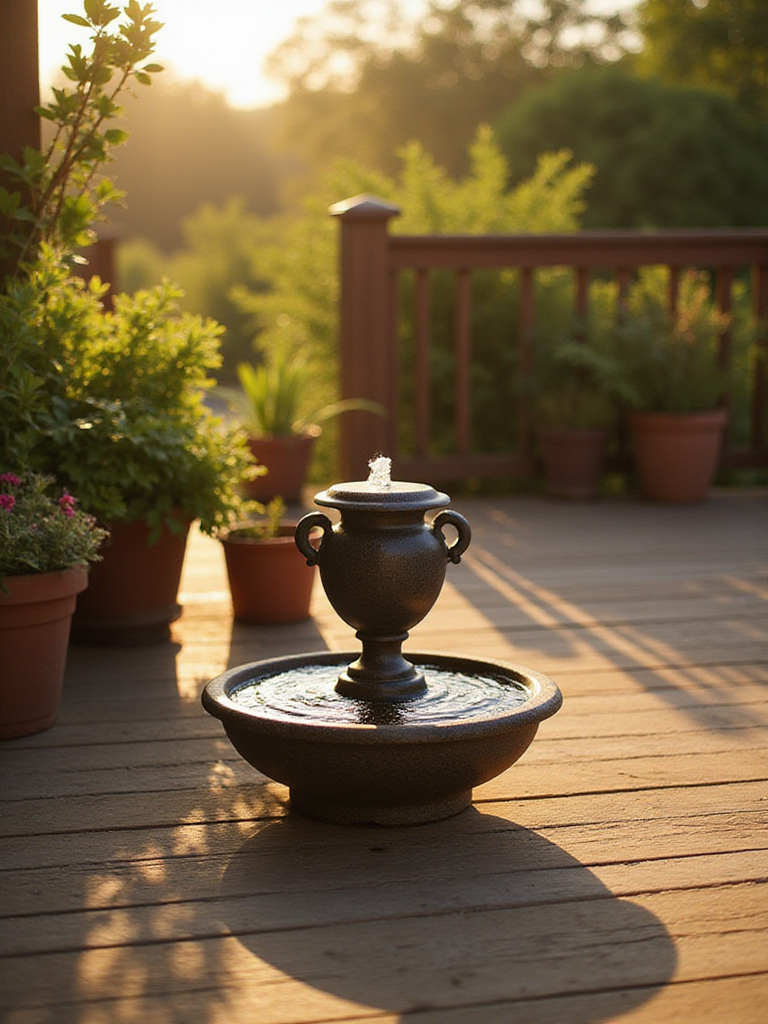
When selecting a water feature for your deck decor, consider weight limitations and access to electricity (or choose solar-powered options). Self-contained units with recirculating pumps are ideal, requiring minimal maintenance while providing maximum enjoyment. Position your water feature where you can enjoy both its sound and appearance from your primary seating area, perhaps adjacent to fragrant herbs or flowers that will complement the sensory experience.
“Water in motion brings life to static spaces—it’s the element that makes a deck feel like a complete ecosystem rather than just an outdoor room.”
Running your hand across this material reveals how water features can create microclimates on your deck, benefiting nearby plants that appreciate higher humidity. Next, consider how adding art can further personalize your outdoor sanctuary.
9. Hang Outdoor Wall Art for Personality
Even in smaller spaces, here’s how outdoor art works to transform your deck decor: it adds dimension, expresses personality, and creates focal points that draw the eye beyond potted plants and furniture. Weather-resistant wall art—whether metal sculptures, mosaic pieces, or specially treated prints—turns blank walls and fences into gallery spaces that reflect your aesthetic sensibilities.

For the urban gardener, art that complements your growing efforts creates thematic consistency. Consider botanical prints protected for outdoor use, metal sculptures of plants or pollinators, or even functional art like decorative thermometers or rain gauges that serve your gardening needs. Mount pieces at varying heights to create visual movement, and ensure everything is securely fastened to withstand wind and weather. I often recommend clustering smaller pieces for greater impact or selecting one statement piece that anchors the space.
The silhouette draws inspiration from natural elements, creating harmony between artistic expressions and living plants. As evening temperatures drop, you’ll want to consider how to extend your enjoyment of this curated outdoor space.
10. Add Warmth with a Fire Pit or Table
For those worried about maintenance, modern fire features offer remarkable convenience while dramatically extending your deck’s usable season. A properly selected fire pit or table becomes the natural gathering point on cool evenings, drawing friends and family into conversation circles that linger long after sunset. The gentle warmth and hypnotic flames create an atmosphere that no other deck decor element can match.

Safety comes first when selecting a fire feature for your deck. Propane or natural gas options eliminate concerns about flying embers that could damage plants or deck materials, while providing adjustable flames and easy control. For wood decks, always use protective barriers designed to prevent heat transfer, and position the fire feature away from overhead structures and flammable materials. Some innovative fire tables even incorporate growing spaces around their perimeters, allowing you to showcase heat-loving herbs like rosemary or lavender that release aromatic oils when warmed.
- Gas fire tables offer clean, controllable flames with minimal maintenance
- Elevated fire bowls add dramatic lighting while keeping flames at a safe height
- Tabletop fire features work well for smaller decks with limited space
- Bioethanol options burn cleanly without requiring gas lines or venting
The interplay between the colors creates a magical evening ambiance that complements your daytime growing activities. Now let’s consider how to make the most of your deck for dining among your edible landscape.
11. Set Up a Functional Outdoor Dining Area
The challenge of awkward spaces becomes easier when you approach outdoor dining with flexibility in mind. A dedicated eating area transforms your deck into a true outdoor kitchen extension, allowing you to enjoy meals surrounded by the very plants that might have contributed to your dish. For urban gardeners, this farm-to-table connection creates a deeply satisfying cycle of growing, harvesting, preparing, and enjoying food in the same space.

Select weather-resistant dining furniture that matches your entertaining style—extendable tables accommodate occasional larger gatherings, while bistro sets work perfectly for intimate meals or smaller decks. Consider height carefully; counter-height tables allow diners to enjoy distant views over railing heights, while standard dining height maintains connection with surrounding container gardens. Ensure adequate space for chair movement (typically 36 inches from table edge to any obstruction) and position the dining area conveniently close to your home’s kitchen door to facilitate food transport.
The renewable resources used here demonstrate how sustainable materials like bamboo, recycled plastic, or responsibly harvested woods can create beautiful, durable dining settings. For those who enjoy entertaining, the next element takes your hosting capabilities to another level.
12. Use a Bar Cart for Easy Entertaining
If you’ve been working behind the scenes on something special, a stylish bar cart might be the perfect finishing touch for your deck decor. These mobile entertaining stations eliminate constant trips to the kitchen, allowing you to remain present with guests while serving drinks and snacks. For the urban gardener, a bar cart becomes even more valuable—it’s the perfect place to showcase homegrown cocktail ingredients like mint, basil, cucumber, or edible flowers.

Look for weather-resistant carts with sturdy wheels that can navigate deck surfaces smoothly. Features like removable trays, wine glass racks, and storage compartments maximize functionality. Position your cart near seating areas but out of primary traffic paths. Stock it with essentials based on your entertaining style—perhaps a selection of locally distilled spirits, tools for crafting garden-inspired cocktails, or simply a collection of refreshing non-alcoholic options garnished with your homegrown herbs.
The traditional methods used result in pieces that combine beauty and function—a hallmark of thoughtful deck decor. As lovely as outdoor entertaining can be, protection from the elements ensures your deck remains comfortable throughout the day.
13. Provide Shade with a Patio Umbrella or Sail
Many homeowners wonder how to create comfortable outdoor spaces that work throughout the day, not just during perfect weather conditions. Strategic shade solutions transform a sun-baked deck into an all-day retreat while protecting plants that might suffer from intense afternoon exposure. The right shade structure becomes both a practical necessity and a defining architectural element of your deck decor.

Consider how sun patterns change across your deck throughout the day and seasons. Adjustable options like cantilever umbrellas can track the sun’s movement, providing targeted shade where needed. For more permanent coverage, shade sails offer contemporary style while allowing some light filtration—ideal for decks where plants require dappled rather than deep shade. Multiple smaller shade elements often work better than one large one, allowing you to create both sunny and shaded microclimates that serve different plants and activities.
The material sourcing makes all the difference in how your shade elements perform and look over time. With your horizontal space optimized, it’s time to explore the vertical dimension of your deck.
14. Incorporate Vertical Gardening or Living Walls
The artisans behind these designs began with the challenge of maximizing growing space in urban environments where ground-level gardening isn’t always possible. Vertical gardening systems transform deck walls, railings, and dividers into productive growing spaces, dramatically increasing your cultivation area without consuming precious floor space. These living installations become stunning visual features while producing herbs, greens, and even compact vegetables.

Several vertical systems work particularly well on decks. Pocket planters made from weather-resistant fabric can hang on walls or railings, creating tapestries of edible and ornamental plants. Modular systems with individual cells allow for customized arrangements and easy plant replacement. Gutters repurposed as horizontal planters can be staggered on walls for growing shallow-rooted crops like lettuce, strawberries, and herbs. When selecting a system, consider weight when fully saturated, drainage management to protect deck surfaces, and accessibility for harvesting and maintenance.
- Pocket systems work well for herbs and compact greens
- Trellis panels support climbing vegetables like peas and beans
- Modular wall systems allow for seasonal rearrangement
- Repurposed rain gutters create affordable horizontal planters
The unexpected environmental benefit comes from the cooling effect these living walls provide, creating more comfortable microclimates on your deck. To enhance the sensory experience further, consider how sound can complement your visual elements.
15. Add Gentle Sounds with Wind Chimes
The emotional response this evokes begins with the gentle, random melody of wind chimes responding to the slightest breeze. These simple instruments add an auditory dimension to your deck decor that complements the visual and tactile elements you’ve already incorporated. For urban gardeners, the gentle tinkling can mask city noise while signaling air movement beneficial for plant pollination and cooling.

Choose chimes based on the sound quality you find most pleasing—aluminum tubes produce clear, long-lasting tones, while bamboo creates softer, more organic sounds. Consider the size of your deck when selecting; smaller spaces benefit from more delicate sounds that won’t overwhelm the area. Position chimes where they’ll catch natural air currents but not become annoying during windy periods. Some gardeners place different types of chimes around their deck to signal varying wind directions, which can inform plant care decisions.
What separates artisanal quality from mass-produced is the tuning—properly tuned wind chimes create harmonious notes rather than random clanging. With pleasant sounds established, let’s explore how to maximize your railing space for both beauty and function.
16. Utilize Decorative Deck Railing Planters
Look closely and you’ll notice the subtle texture of railing planters transforming ordinary deck boundaries into productive growing spaces. These specialized containers attach securely to railings, converting otherwise unused vertical space into prime real estate for flowers, herbs, and compact vegetables. For urban gardeners with limited deck area, railing planters can significantly increase growing capacity while adding vibrant color and texture.

Select planters designed specifically for your railing type—whether wood, metal, or composite—ensuring they attach securely without damaging the structure. Consider weight distribution when planning your railing garden; alternate heavier planters with lighter ones, and verify that your deck railing can support the added weight when plants are fully grown and watered. Self-watering options reduce maintenance and water waste, while cascading varieties like trailing herbs, nasturtiums, or strawberries create dramatic visual impact.
“Railing planters create eye-level interest—perfect for fragrant herbs you can brush against while passing or compact vegetables you can harvest without bending.”
Beyond the obvious placement, consider using these for accessible herb gardens positioned right outside your kitchen door. For those seeking to soften the overall look of their deck decor, fabric elements offer the perfect solution.
17. Install Outdoor Curtains for Softness and Shade
The inspiration for this collection struck when observing how fabric elements transform rigid deck structures into softer, more inviting spaces. Outdoor curtains add a resort-like luxury to your deck decor while serving multiple practical purposes: providing adjustable shade, creating privacy screens, reducing wind, and defining distinct areas within your outdoor living space.

Select fabrics specifically manufactured for outdoor exposure—solution-dyed acrylics or marine-grade polyester resist fading, mildew, and water damage. Install curtain rods or cables securely, ensuring they can withstand occasional wind gusts without pulling away from mounting points. Consider how the curtains will move in the breeze; weights sewn into hems help prevent excessive billowing, while tie-backs allow you to adjust coverage as needed. For urban gardeners, curtains can create protected microclimates for sensitive plants by blocking harsh afternoon sun or buffering wind.
The ambient experience changes the entire room’s energy when these flowing elements respond to gentle breezes. Before adding more decorative elements, ensure your deck’s foundation looks its best.
18. Update the Deck Surface with Stain or Paint
The quality becomes evident after years of use when properly finished deck surfaces maintain their integrity and appearance. A fresh coat of stain or paint does more than just improve aesthetics—it protects your investment from weathering, extends the life of the decking material, and creates a clean canvas for your carefully selected deck decor elements.

For urban gardeners, deck surface treatment requires special consideration. Choose products labeled as plant-safe once cured, particularly if you’re growing edibles in containers that might come in contact with the surface. Consider colors that complement your plantings and furniture—warm cedar tones work beautifully with terra cotta pots, while cool grays provide contemporary contrast to vibrant greenery. Semi-transparent stains allow wood grain to show through while adding color, creating a natural look that ages gracefully.
- Clean thoroughly with appropriate deck cleaner before application
- Allow wood to dry completely (typically 48 hours) before staining or painting
- Apply when temperatures are between 50-90°F for optimal results
- Consider slip-resistant additives for areas that get wet from plant watering
The revival of this classic form comes with a twist—modern, eco-friendly stains and paints that offer protection without harsh chemicals that might harm your garden ecosystem. With your deck surface refreshed, practical storage solutions become the next priority.
19. Add Stylish Storage Solutions
The maker’s journey from apprentice to master influenced how we approach deck storage—blending functionality with aesthetics to create pieces that solve problems while enhancing your outdoor space. Strategic storage solutions keep gardening supplies, cushions, and entertaining essentials organized and protected, preventing clutter that would detract from your carefully designed deck decor.

Weather-resistant deck boxes that double as seating make excellent use of limited space. Look for ventilated designs that prevent moisture buildup—crucial for storing garden tools that might rust or cushions that could develop mildew. Vertical cabinets positioned against walls maximize floor space while providing easy access to frequently used items. For urban gardeners, specialized storage for tools, soil, and amendments keeps everything organized and accessible, making garden maintenance more efficient and enjoyable.
For those hesitant about bold patterns, storage pieces in neutral tones blend seamlessly with most deck designs while providing essential functionality. Proper lighting ensures you can navigate your well-organized deck safely after sunset.
20. Illuminate Pathways with Deck or Step Lighting
The finishing touch that elevates the entire look comes from thoughtfully placed pathway and step lighting. Beyond the obvious safety benefits of illuminating level changes and edges, strategic lighting extends the usability of your deck into evening hours—essential for urban gardeners who might tend plants after work or harvest for dinner preparations.

Low-profile recessed lights installed directly into deck boards or risers provide subtle illumination without creating tripping hazards. Solar-powered options eliminate the need for wiring, making them ideal for retrofitting existing decks, while low-voltage systems offer consistent brightness regardless of weather conditions. Position lights to highlight transitions between different deck zones, illuminate steps, and create gentle pools of light around seating areas. For growing areas, consider how nighttime illumination affects plants—many benefit from true dark periods, so direct lighting away from sensitive species.
The evolution of this trend reflects broader cultural shifts toward outdoor living spaces that function around the clock and throughout the seasons. With your deck now beautiful and functional day and night, seasonal accessories add the final layer of personalization.
21. Personalize with Themed or Seasonal Accessories
As morning light filters through, the texture creates different moods throughout the year—something seasonal accessories can enhance beautifully. Rotating decorative elements with the seasons keeps your deck decor fresh and responsive to changing weather patterns and activities. Spring might feature bright planters with seedlings and pastel accessories, while summer calls for vibrant colors and entertaining essentials.

Urban gardeners can align seasonal decor with their growing calendar—celebrating harvest season with displays of produce and preserved goods, or winter with evergreen arrangements and cold-hardy plantings. Invest in quality, weather-resistant core pieces, then layer in seasonal items that can be stored when not in use: autumn-hued pillows and lanterns, summer serving pieces, or spring container arrangements. This approach keeps your deck feeling current without requiring complete redesigns.
- Spring: Seed-starting stations, rain gauges, pastel accents
- Summer: Harvest baskets, outdoor dinnerware, bright textiles
- Fall: Preserved flower arrangements, warm-toned accessories, lanterns
- Winter: Evergreen plantings, outdoor-safe string lights, weather-resistant wreaths
When your existing decor doesn’t seem to coordinate with seasonal changes, simple textile swaps and container rotations can create dramatic transformations without major investments.
Conclusion
Creating thoughtful deck decor is about more than just aesthetics—it’s about designing a space that supports your lifestyle, connects you with nature, and maximizes the potential of your outdoor square footage. For urban gardeners especially, a well-designed deck becomes an extension of living space and a productive growing area that nourishes both body and spirit.
The 21 ideas we’ve explored demonstrate how function and beauty can coexist harmoniously. From comfortable seating arrangements that invite lengthy conversations to vertical gardens that transform walls into productive growing spaces, each element contributes to a deck that feels intentional and alive. By approaching your deck as a dynamic ecosystem rather than a static platform, you’ll create a space that evolves with the seasons and continues to inspire year after year.
Remember that the most successful deck transformations happen gradually—start with the elements that address your most pressing needs or inspire you most deeply, then build upon that foundation as time and budget allow. Your deck has the potential to become not just your favorite room in the house, but a vibrant, productive extension of your urban lifestyle.


